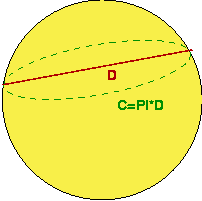Some Examples of Strategies for the Rotation Activity
Below are a couple of methods students might come up with. It is important to
note that we do not intend for this list to be comprehensive, and in fact we
hope that the students will come up with ideas that escaped us!
 Students
track the movement of a particular sunspot over the course of a few days days.
They then measure the distance the sunspot moves across the image of the sun
in a day and divide this number into the observed circumference of the sun at
the sunspot's latitude. ("Observed circumference . . ." refers to the number
arrived at by multiplying the width of the sun's image at the given latitude
times Pi). This should yield the sun's approximate rotational period.
Students
track the movement of a particular sunspot over the course of a few days days.
They then measure the distance the sunspot moves across the image of the sun
in a day and divide this number into the observed circumference of the sun at
the sunspot's latitude. ("Observed circumference . . ." refers to the number
arrived at by multiplying the width of the sun's image at the given latitude
times Pi). This should yield the sun's approximate rotational period.
- Just like the above method, except that the spot's movement over the
course of, say, five days is measured. This quantity is then divided into the
observed circumference of the sun, and the result is multiplied by the number
of days, five in this instance.
- This method might occur to kids who are a bit less trusting of math. It is
essentially the same as method 1, but is less analytical (as such, a
discussion comparing the two methods can be very helpful to those kids who
need to work on their level of comfort with math). Basically, a string is used
to measure the circumference of the Sun, and a ruler measures the distance
d a spot travels in a day. At this point, there are a few variations,
but the basic idea is that they count how many times d will fit into
the measured circumference. Of course, this counting is a way of doing
division, and it is important that the kids see this.
Students could count the number of days it takes for a sunspot to get from
the center of the sun's image to the very edge. This corresponds to a fourth
of a complete rotation, so four times this number of days should be the
approximate rotational period. This is clearly the simpler idea to understand,
but it may be difficult to implement with much precision, since it can be
surprisingly hard to see when a spot gets to "the very edge."
 Students
track the movement of a particular sunspot over the course of a few days days.
They then measure the distance the sunspot moves across the image of the sun
in a day and divide this number into the observed circumference of the sun at
the sunspot's latitude. ("Observed circumference . . ." refers to the number
arrived at by multiplying the width of the sun's image at the given latitude
times Pi). This should yield the sun's approximate rotational period.
Students
track the movement of a particular sunspot over the course of a few days days.
They then measure the distance the sunspot moves across the image of the sun
in a day and divide this number into the observed circumference of the sun at
the sunspot's latitude. ("Observed circumference . . ." refers to the number
arrived at by multiplying the width of the sun's image at the given latitude
times Pi). This should yield the sun's approximate rotational period.